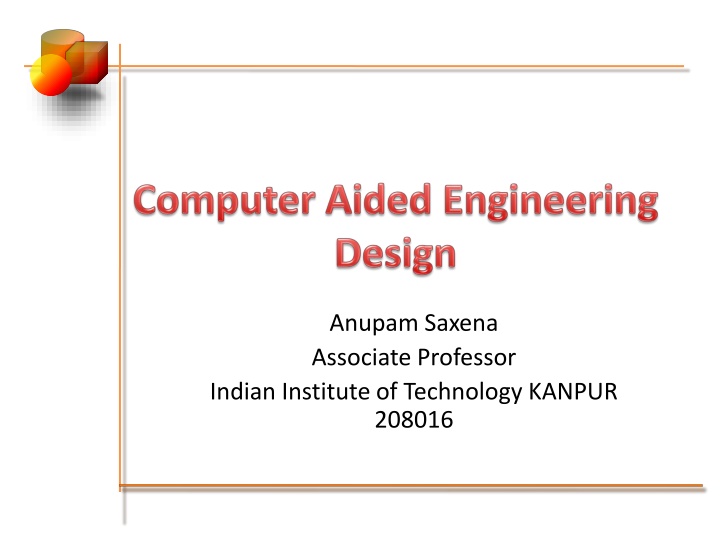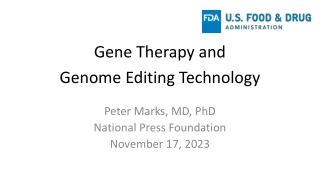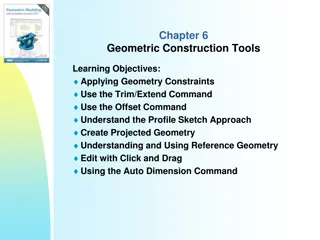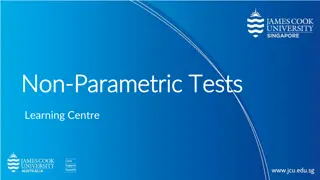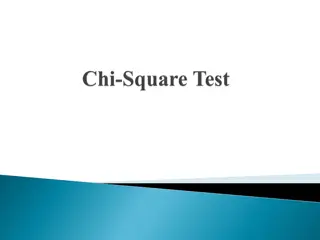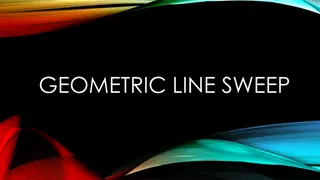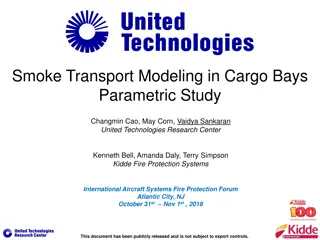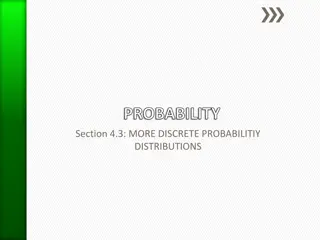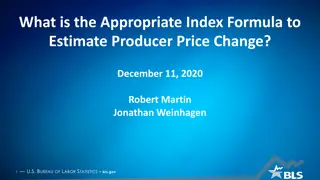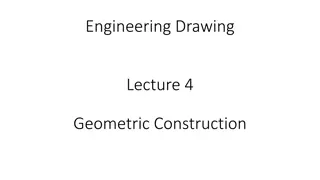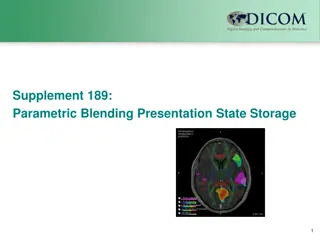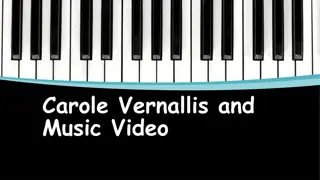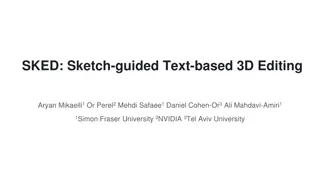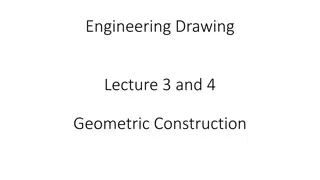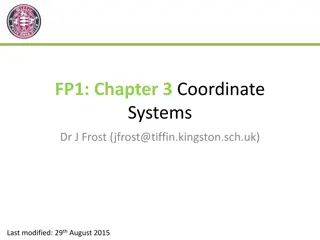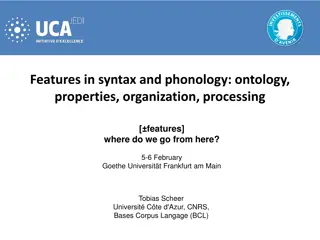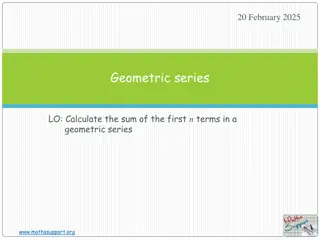Geometric/Parametric Modeling and Editing of Polyhedrons
Create and modify polyhedron models using geometric and parametric modeling techniques. Learn about Euler operators for adding or deleting edges, vertices, faces, and genus. Explore concepts like solid modeling, differential geometry, and NURBS to construct and manipulate polyhedrons efficiently.
Download Presentation

Please find below an Image/Link to download the presentation.
The content on the website is provided AS IS for your information and personal use only. It may not be sold, licensed, or shared on other websites without obtaining consent from the author.If you encounter any issues during the download, it is possible that the publisher has removed the file from their server.
You are allowed to download the files provided on this website for personal or commercial use, subject to the condition that they are used lawfully. All files are the property of their respective owners.
The content on the website is provided AS IS for your information and personal use only. It may not be sold, licensed, or shared on other websites without obtaining consent from the author.
E N D
Presentation Transcript
Anupam Saxena Associate Professor Indian Institute of Technology KANPUR 208016
Given a polyhedron model, one may want to edit it by adding or deleting edges, vertices, faces and genus to create a new polyhedron Geometric/PARAMETRIC Modeling Modeling of Surfaces (Patches) Modeling of Curves Solid Modeling Representatio n, Differential Geometry Perception of Solids Differential Geometry Topology and Solids Ferguson Segments Tensor Product Solid Modeling 1-2 Bezier Boundary Interpolating Segments 1-2 Transformatio ns and Projections 1-2 B-splinecurves 1-5 Composite NURBS NURBS One can use Euler operators
Euler operators are written as Mxyz or Kxyz Geometric/PARAMETRIC Modeling M for Make and K for Kill groups Modeling of Surfaces (Patches) Modeling of Curves Solid Modeling Representatio n, Differential Geometry Perception of Solids Differential Geometry Topology and Solids Ferguson Segments Tensor Product x, y and z represent a vertex, edge, face, loop, shell or genus Solid Modeling 1-2 Bezier Boundary Interpolating Segments 1-2 Transformatio ns and Projections 1-2 B-splinecurves 1-5 Composite NURBS NURBS e.g., MEV adding an edge and a vertex KEV killing (deleting) an edge and a vertex
Operators are designed such that Geometric/PARAMETRIC Modeling Modeling of Surfaces (Patches) Modeling of Curves Solid Modeling V E + F (L F) 2(S G) = 0 Representatio n, Differential Geometry Perception of Solids Differential Geometry Topology and Solids Ferguson Segments Tensor Product Solid Modeling 1-2 Bezier Boundary Interpolating Segments 1-2 Transformatio ns and Projections 1-2 B-splinecurves 1-5 Composite is always satisfied NURBS NURBS using a finite sequence of operators, any polyhedron can be constructed from any other, or from scratch
Change in Euler- Poincar formula Operato r Implication V E F L S G Make an edge and a vertex + 1 MEV +1 0 + 1 + 1 + 1 + 1 MFE Make a face and an edge +1 0 Make a shell, a face and a vertex Make a shell and a genus Make an edge, Kill and loop + 1 MSFV +1 0 + 1 MSG +1 0 1 MEKL +1 0 Geometric/PARAMETRIC Modeling Modeling of Surfaces (Patches) Modeling of Curves Solid Modeling Representatio n, Differential Geometry Perception of Solids Differential Geometry Topology and Solids Ferguson Segments Tensor Product Solid Modeling 1-2 Bezier Boundary Interpolating Segments 1-2 Transformatio ns and Projections 1-2 B-splinecurves 1-5 Composite NURBS NURBS
Change in Euler- Poincar formula Operat or Implication V E F L S G 1 1 KEV Kill an edge and a vertex 0 1 1 1 KFE Kill a face and an edge 0 Kill a shell, a face and a vertex 1 1 1 1 KSFV 0 1 1 KSG Kill a shell and a genus 0 + 1 1 KEML Kill an edge, Make a loop 0 Geometric/PARAMETRIC Modeling Modeling of Surfaces (Patches) Modeling of Curves Solid Modeling Representatio n, Differential Geometry Perception of Solids Differential Geometry Topology and Solids Ferguson Segments Tensor Product Solid Modeling 1-2 Bezier Boundary Interpolating Segments 1-2 Transformatio ns and Projections 1-2 B-splinecurves 1-5 Composite NURBS NURBS
Operator V E F L S G Geometric/PARAMETRIC Modeling MSFV MEV MEV MEV MEV MEV MFE MEV MFE MFE MFE MFE MEV +1 +1 +1 +1 +1 +1 +1 +1 +1 Modeling of Surfaces (Patches) Modeling of Curves Solid Modeling +1 +1 +1 +1 +1 +1 +1 +1 +1 +1 +1 +1 Representatio n, Differential Geometry Perception of Solids Differential Geometry Topology and Solids Ferguson Segments Tensor Product Solid Modeling 1-2 Bezier Boundary Interpolating Segments 1-2 Transformatio ns and Projections 1-2 B-splinecurves 1-5 Composite NURBS NURBS +1 +1 +1 +1 +1 +1 +1 +1 +1 +1 +1 +1
CSG for short solids can be generated by combining primitives using Boolean operations. Geometric/PARAMETRIC Modeling Modeling of Surfaces (Patches) Modeling of Curves Solid Modeling Representatio n, Differential Geometry Perception of Solids Differential Geometry Topology and Solids Ferguson Segments Tensor Product Solid Modeling 1-2 Bezier Boundary Interpolating Segments 1-2 Transformatio ns and Projections 1-2 B-splinecurves 1-5 Composite NURBS NURBS Primitives: block, cone, cylinder, sphere, triangular prism, torus and many others. Primitives can also be user-defined solids
Geometric/PARAMETRIC Modeling Modeling of Surfaces (Patches) Modeling of Curves Solid Modeling Representatio n, Differential Geometry Perception of Solids Differential Geometry Topology and Solids Ferguson Segments Tensor Product Solid Modeling 1-2 Bezier Boundary Interpolating Segments 1-2 Transformatio ns and Projections 1-2 B-splinecurves 1-5 Composite NURBS NURBS
Primitives are first instantiated, transformed and then combined to form more complex solids. Geometric/PARAMETRIC Modeling Modeling of Surfaces (Patches) Modeling of Curves Instantiation involves making available a copy of the primitive (if existing) from the database. Solid Modeling Representatio n, Differential Geometry Perception of Solids Differential Geometry Topology and Solids Ferguson Segments Tensor Product Solid Modeling 1-2 Bezier Boundary Interpolating Segments 1-2 Transformation is required to scale or position a primitive with respect to others (or their Boolean result) Transformatio ns and Projections 1-2 B-splinecurves 1-5 Composite NURBS NURBS The primitive may then be joined with, cut from or intersected with an existing solid to get the desired features.
Block 1 Geometric/PARAMETRIC Modeling Modeling of Surfaces (Patches) Modeling of Curves Solid Modeling Block 2 Representatio n, Differential Geometry Perception of Solids Differential Geometry Topology and Solids Ferguson Segments Tensor Product Solid Modeling 1-2 Bezier Boundary Interpolating Segments 1-2 Transformatio ns and Projections 1-2 B-spline curves 1-5 Composite Boolean JOIN transformation NURBS NURBS scaling instantiation scaling transformation instantiation
The block primitives above may be treated as objects named Block 1 and Block 2 They may be identified by the three dimensions (length, width and height) Geometric/PARAMETRIC Modeling Modeling of Surfaces (Patches) Modeling of Curves Solid Modeling The instantiations of initially standard sizes can be at the global origin. Representatio n, Differential Geometry Perception of Solids Differential Geometry Topology and Solids Ferguson Segments Tensor Product One may scale the three dimensions of a block by factors, say x, y and z using the scale command. scale(Block 1, x1, y1, z1). Solid Modeling 1-2 Bezier Boundary Interpolating Segments 1-2 Transformatio ns and Projections 1-2 B-spline curves 1-5 Composite One may translate the block so that the reference point would be shifted by, say (a, b, c) with respect to the origin. translate(scale(Block 1, x1, y1, z1), a1, b1, c1). NURBS NURBS Similar operations for Block 2 would be translate(scale(Block 2, x2, y2, z2), a2, b2, c2). The blocks would be united using the Boolean union or JOIN command JOIN( translate( scale(Block 1, x1, y1, z1), a1, b1, c1) , translate(scale(Block 2, x2, y2, z2), a2, b2, c2))
CSG operations can be represented as a tree Geometric/PARAMETRIC Modeling Modeling of Surfaces (Patches) Modeling of Curves Solid Modeling Representatio n, Differential Geometry Perception of Solids Differential Geometry + Topology and Solids Ferguson Segments Tensor Product Solid Modeling 1-2 Bezier Boundary Interpolating Segments 1-2 Transformatio ns and Projections 1-2 B-spline curves 1-5 Composite NURBS NURBS transform (Block 2) transform (Cylinder 2) Block 2 Cylinder 2 transform (Block 1) transform (Cylinder 1) Block 1 Cylinder 1
Two sets (solids) A and B, Their union (A B) consists of all points belonging to A and B. Their intersection (A B) consists of points common to both A and B Their difference A B consists of points in A but not in B. Similarly, B A would consist of points only in B and not in A. Geometric/PARAMETRIC Modeling Modeling of Surfaces (Patches) Modeling of Curves Solid Modeling Representatio n, Differential Geometry Perception of Solids Differential Geometry Topology and Solids Ferguson Segments Tensor Product Solid Modeling 1-2 Bezier Boundary Interpolating Segments 1-2 Transformatio ns and Projections 1-2 B-spline curves 1-5 Composite NURBS NURBS
Geometric/PARAMETRIC Modeling Modeling of Surfaces (Patches) Modeling of Curves Solid Modeling Representatio n, Differential Geometry Perception of Solids Differential Geometry Topology and Solids Ferguson Segments Tensor Product Solid Modeling 1-2 Bezier Boundary Interpolating Segments 1-2 Transformatio ns and Projections 1-2 B-spline curves 1-5 Composite NURBS NURBS (c) intersection (d) cube sphere (e) sphere cube (b) union
